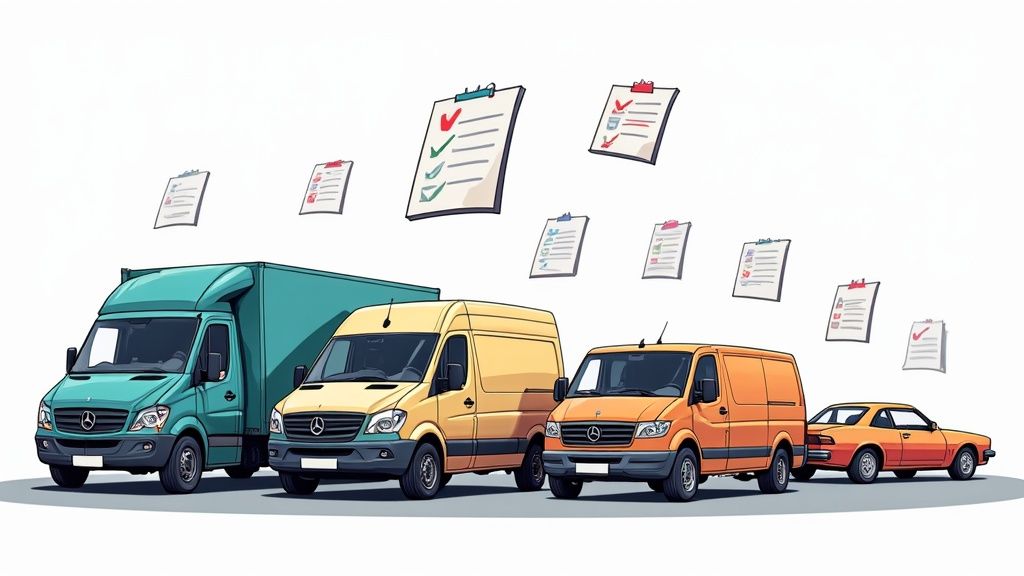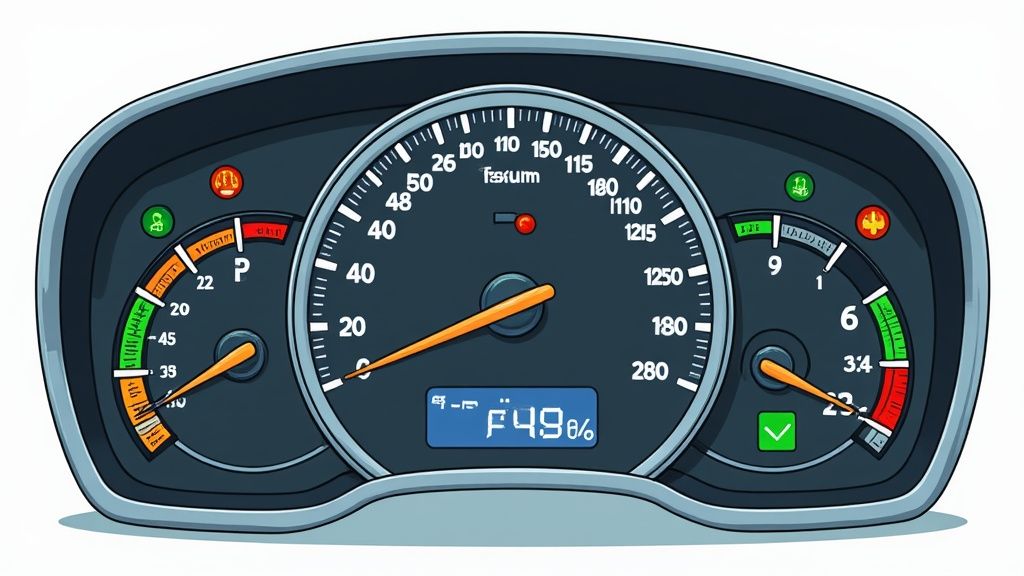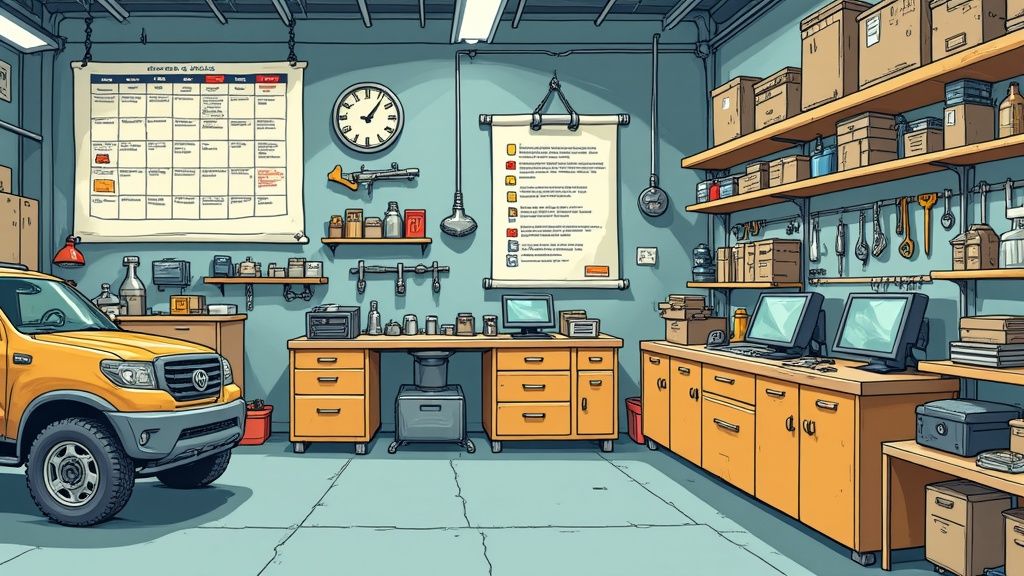
Essential Fleet Vehicle Maintenance Checklist: A Complete Guide to Preventive Success
The Strategic Value of Preventive Fleet Maintenance

Regular maintenance does more than just keep vehicles running - it’s an essential investment in your business’s future. Just as consistent health checkups help prevent medical issues, proactive vehicle care helps avoid costly repairs and downtime. When done right, preventive maintenance becomes a key driver of business success.
Impact on Operational Efficiency
Regular maintenance directly affects how smoothly your business runs day-to-day. For example, delivery companies that stick to consistent maintenance schedules see fewer unexpected breakdowns and can maintain reliable delivery times. This builds customer trust and prevents the chaos of emergency repairs pulling resources away from core operations. The result is a more reliable fleet that lets your team focus on serving customers rather than dealing with vehicle problems.
Cost Savings and ROI
Smart fleet managers know that spending money on prevention saves much more in the long run. Small investments in routine oil changes and inspections help catch issues before they become major problems. Following a detailed fleet vehicle maintenance checklist is key - learn more about creating an effective checklist here. Companies that implement thorough preventive maintenance programs typically see a 20-30% reduction in repair costs while keeping their vehicles on the road longer.
Extending Vehicle Lifespan
Regular maintenance helps vehicles last significantly longer, similar to how good health habits extend human lifespans. Keeping up with service schedules ensures all parts work properly and wear evenly. Well-maintained commercial vehicles often last 2-3 years longer than poorly maintained ones. This extended lifespan means you can delay expensive replacements and get more value from your current fleet.
Enhancing Vehicle Safety
Safety should be every fleet manager’s top priority - and maintenance plays a crucial role. Regular inspections catch worn brakes, bad alignment, and other issues before they cause accidents. This protects your drivers, other motorists, and your company’s reputation. Insurance companies often offer discounts of 10-15% for fleets with strong maintenance records, making safety programs financially smart too. Beyond compliance, a commitment to maintenance shows you take your responsibility to public safety seriously.
Building Your Comprehensive Maintenance Checklist

A strong fleet vehicle maintenance checklist helps keep operations smooth and vehicles roadworthy. When done right, these checklists prevent breakdowns, manage costs effectively, and make sure drivers stay safe on the road. Creating the right checklist means understanding what your vehicles need and when they need it.
Structuring Your Maintenance Schedules
Think of maintenance schedules like your vehicle’s health plan - some checks happen daily, others weekly, monthly or yearly. Just as you visit your doctor for different types of checkups, vehicles need varying levels of care:
- Daily Vehicle Checklist: Quick safety checks before each trip cover the basics. Drivers check tire pressure, fluid levels, lights, and seatbelts. Catching small issues early stops them from becoming major problems.
- Weekly Vehicle Checklist: These deeper checks examine brake systems, look for fluid leaks, and test wipers and other key parts.
- Monthly Vehicle Checklist: Monthly inspections get more detailed, measuring tire tread depth, lubricating moving parts, and doing full engine performance reviews.
- Annual Vehicle Checklist: Professional mechanics handle these thorough inspections. They examine all major systems - emissions, transmission, cooling - to make sure vehicles meet safety rules and run efficiently.
Customizing Inspections for Different Vehicle Types
Each type of vehicle has specific maintenance needs. For example, delivery vans that make frequent stops need more regular brake checks than long-haul trucks. But those same trucks require extra attention to tires and engines for their highway miles. Your checklists should match each vehicle’s actual use.
Vehicle usage patterns also affect maintenance timing. High-mileage vehicles need more frequent checks than those driven less. Vehicles working in tough conditions - extreme weather or rough terrain - require special care. By matching maintenance to real needs, you protect each vehicle properly.
Keeping up with preventive maintenance is crucial for success. Fleet managers should aim for at least a 95% compliance rate with scheduled maintenance. Using fleet management software helps track these tasks effectively. Regular data review shows maintenance patterns and guides smart decisions about repairs and replacements. Learn more about preventive maintenance compliance here. Following this organized approach creates a solid foundation for keeping your fleet running smoothly.
Navigating Modern Fleet Maintenance Challenges

Running a successful vehicle fleet requires careful attention to maintenance and repairs. Fleet managers face several key challenges that directly impact their operations and bottom line, from managing costs to ensuring vehicle reliability. Understanding and addressing these issues is essential for keeping vehicles on the road and operations running smoothly.
Managing Escalating Maintenance Costs
The rising cost of repairs and maintenance represents one of the biggest hurdles for fleet operators. Recent industry data shows concerning trends - during the first half of 2023, repair costs increased by up to 20% across many fleet sectors. This spike stems primarily from major repairs like engine and transmission work rather than basic maintenance. For more details on these cost trends, see this comprehensive fleet maintenance analysis.
Overcoming Parts Shortages
Getting replacement parts quickly has become increasingly difficult due to ongoing supply chain issues. When vehicles are sidelined waiting for parts, it disrupts operations and cuts into productivity. Smart fleet managers are adapting by:
- Building relationships with multiple parts suppliers
- Keeping critical components in stock when possible
- Finding reliable alternative parts sources
- Planning ahead for anticipated maintenance needs
Addressing the Skilled Labor Gap
Finding and keeping skilled technicians presents another significant challenge. As experienced mechanics retire, fewer new technicians are entering the field to replace them. This shortage drives up labor costs and can lead to maintenance delays. Solutions include developing in-house training programs and partnering with technical schools. Digital tools like Auto Service Logger can help by streamlining maintenance tracking and documentation.
Building a Resilient Fleet Maintenance Program
Creating an effective maintenance program requires a systematic approach built on proven best practices. Key elements include detailed maintenance checklists customized for each vehicle type, regular inspections, and thorough documentation. When supported by the right combination of tools, training and partnerships, this foundation helps fleets minimize downtime and control costs while keeping vehicles running reliably for the long term.
Designing Your Winning Maintenance Strategy

A strong maintenance strategy forms the foundation of any successful fleet operation. It goes beyond just following a basic checklist - it requires careful planning that keeps vehicles running while preventing costly breakdowns. By taking a proactive approach, fleet managers can minimize downtime and keep operations running smoothly.
Balancing Preventive Care and Operational Demands
Managing fleet maintenance is like walking a tightrope. You need regular preventive care to catch issues early, but vehicles also need to stay on the road to meet business needs. Successful fleet managers achieve this balance through smart scheduling and resource planning. For instance, staggering maintenance across the fleet ensures enough vehicles remain available for daily operations.
Optimizing Resource Allocation and Maintenance Scheduling
Making the most of your maintenance resources means strategic planning of both budget and staff time. Different vehicles have different needs - delivery vans doing frequent stops need more brake inspections than highway trucks. By analyzing usage patterns, you can schedule maintenance when it impacts operations least. This targeted approach helps prevent both over-maintenance and costly repairs from neglect.
Implementing Effective Maintenance Windows
Setting specific timeframes for maintenance helps minimize disruption to your operations. Smart scheduling during off-peak hours or overnight keeps vehicles available when needed most. For example, planning oil changes and inspections during natural downtime prevents taking trucks off the road during busy delivery windows. The key is finding maintenance windows that work with your fleet’s natural rhythms.
Adapting Your Strategy to Unique Fleet Needs
No two fleets face exactly the same maintenance challenges. Long-haul trucks have very different needs than local delivery vans. External factors like weather conditions also impact maintenance timing. Recent supply chain issues and rising costs have forced many fleets to adjust their approach. While some managers have shifted to more reactive maintenance to control short-term costs, preventive care remains the most cost-effective long-term strategy. Learn more about managing rising fleet costs here.
Implementing and Tracking Your Program
Putting your strategy into action requires organization and accountability. Start with a detailed maintenance checklist that outlines specific tasks and schedules. Auto Service Logger provides tools to track maintenance activities and analyze results. Regular program reviews help identify what’s working and where adjustments are needed. This systematic approach keeps your maintenance program on track and your fleet running efficiently.
Modern Technology in Fleet Maintenance
Fleet managers now have access to digital tools that make vehicle maintenance simpler, smarter, and more cost-effective than ever before. The right technology helps teams catch problems early, reduce repair costs, and keep vehicles running safely. Let’s explore the key tools that are making a real difference in fleet maintenance.
Maintenance Management Software: Your Command Center
Maintenance management software acts as the brain of your fleet’s maintenance program by organizing all vehicle care in one place. Here’s what these platforms typically handle:
- Digital Maintenance Checklists: Switch from paper lists to digital tracking that ensures no inspection or service gets missed
- Live Vehicle Location & Status: Monitor where vehicles are and how they’re performing in real-time
- Automatic Service Alerts: Get reminders when maintenance is due to prevent missed services
- Parts Inventory Control: Keep track of parts and supplies to ensure you have what you need when you need it
Diagnostic Tools: Spotting Problems Early
Modern diagnostic tools do more than find existing issues - they help prevent future breakdowns. Using sensors and data analysis, these tools can spot early warning signs of part wear before failures occur. It’s similar to how regular health screenings help doctors catch medical issues early.
For instance, onboard sensors track tire pressure, engine metrics, and other key data points. When something looks off, the system alerts managers so they can schedule repairs proactively. This preventive approach helps avoid emergency repairs and keeps vehicles running smoothly.
Mobile Inspection Apps: Putting Tools in Drivers’ Hands
Mobile inspection apps make it easy for drivers to do thorough vehicle checks using their phones or tablets. They can quickly document issues with photos and notes during pre-trip and post-trip inspections. This information goes straight to the maintenance team so they can address problems quickly.
Selecting Your Technology Tools
When choosing maintenance technology for your fleet, focus on finding tools that match your specific needs and budget. Auto Service Logger, for example, offers comprehensive maintenance tracking, mileage logging, and custom reporting features. These capabilities help with warranty documentation, vehicle resale value, and overall fleet management.
Key factors to consider:
- User-Friendly Design: Both drivers and maintenance staff should find the tools simple to use
- System Compatibility: New tools should work well with your existing fleet management systems
- Room for Growth: Choose solutions that can expand as your fleet gets bigger
- Total Investment: Factor in software costs, hardware needs, and training requirements
By implementing the right technology tools, fleet managers can shift from fixing problems after they occur to preventing them before they happen. This leads to more reliable vehicles, lower maintenance costs, and safer operations overall.
Future-Proofing Your Fleet Maintenance Program
A well-designed fleet maintenance checklist is just the starting point for effective fleet management. Success requires planning ahead and creating systems that can grow and adapt over time. Let’s explore key strategies to build a maintenance program ready for whatever comes next.
Embracing Emerging Technologies in Fleet Maintenance
Smart technology is reshaping how fleets handle maintenance work. Predictive maintenance tools now serve as an early alert system - using sensors and software to spot potential issues before they cause breakdowns. By catching problems early, fleets can schedule repairs proactively and keep vehicles running longer.
Telematics systems do much more than just track vehicle locations. These tools provide detailed data about how vehicles are performing, how they’re being driven, and how much fuel they use. For example, telematics can alert managers when vehicles are idling excessively, which leads to extra engine wear and wasted fuel.
Adapting to Evolving Maintenance Practices
The growing adoption of electric vehicles (EVs) brings new considerations for fleet maintenance teams. While EVs have fewer moving parts than traditional vehicles, they require different expertise for battery care and electrical systems. Staying current on EV maintenance best practices will be crucial as more fleets add electric options.
Data analytics is becoming central to maintenance planning. By examining information from multiple sources like telematics and service records, fleets can spot patterns that help optimize their maintenance timing and processes. This data-driven approach leads to smarter decisions about when and how to service vehicles.
Building a Flexible and Scalable Program
Your maintenance program needs room to expand as your fleet grows. Tools like Auto Service Logger provide the flexibility to track maintenance across more vehicles while generating useful performance reports.
Think of your maintenance checklist as an evolving guide. Review and update it regularly based on your actual needs, new vehicle types, and changing industry standards. For instance, when adding different vehicle models, include their specific maintenance requirements in your checklist.
Strategic Planning for Long-Term Success
Creating an effective long-term maintenance strategy means looking beyond immediate needs. Consider factors like future vehicle purchases, new technologies, and upcoming regulations. Planning ahead helps prevent problems before they arise.
Start by setting clear maintenance goals - whether that’s minimizing vehicle downtime, reducing repair costs, or improving safety records. With defined objectives in place, you can map out the steps needed to achieve them.
Future-proofing fleet maintenance requires ongoing attention and adjustment. By adopting helpful technologies, staying informed about industry changes, and maintaining a long-term focus, you can keep your fleet running efficiently and safely year after year.
Ready to improve your fleet maintenance program? Auto Service Logger offers tools to streamline maintenance tracking, monitor vehicle health, and make better decisions using real data. Try it free today and see how modern maintenance management can benefit your fleet.